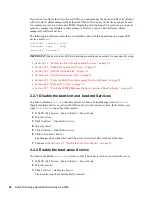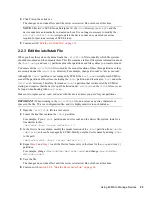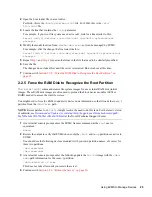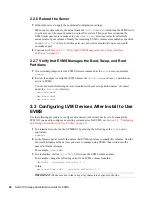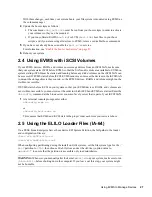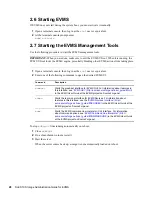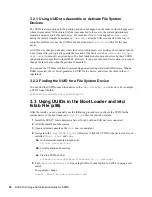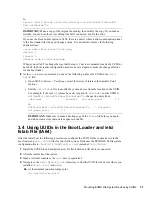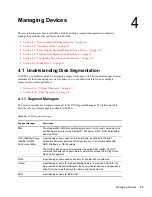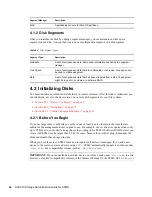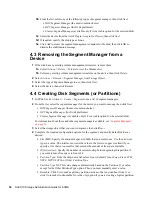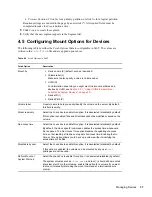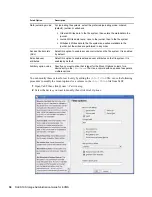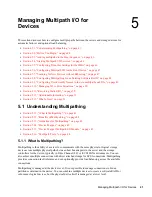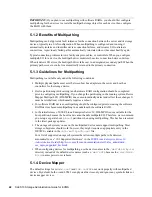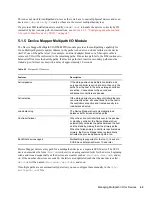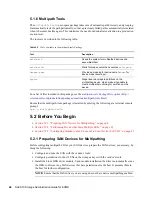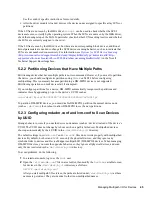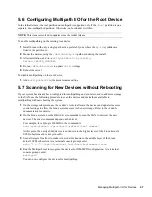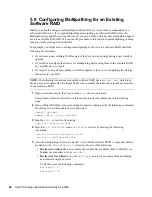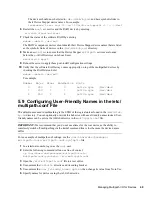
36
SLES 10 Storage Administration Guide for EVMS
no
vd
ocx (
E
NU)
9
Jan
uar
y 2
007
3b
From the list, select one of the following types of segment manager, then click
Next
.
DOS Segment Manager
(the most common choice)
GPT Segment Manager
(for IA-64 platforms)
Cluster Segment Manager
(available only if it is a viable option for the selected disk)
3c
Select the device from the list of
Plugin Acceptable Objects
, then click
Next
.
3d
If required, specify the disk type as Linux.
3e
Click
Add
to create the segment management container for the disk, then click OK to
dismiss the confirmation message.
4.3 Removing the Segment Manager from a
Device
1
If the disk has any existing volume management structures, remove them.
1a
Select
Actions > Delete > Volume
to view the Volumes list.
1b
Select any existing volume management structures on the device, then click
Delete
.
2
Select
Actions > Remove > Segment Manager from Storage Object
.
3
Select the type of Segment Manager in use, then click
Next
.
4
Select the device, then click Remove.
4.4 Creating Disk Segments (or Partitions)
1
In EVMS, select
Actions > Create > Segment
to see a list of segment managers.
2
From the list, select the segment manager for the device you want to manage, then click
Next
.
DOS Segment Manager
(the most common choice)
GPT Segment Manager
(for IA-64 platforms)
Cluster Segment Manager
(available only if it is a viable option for the selected disk)
For information about these and other segment managers available, see
“Segment Managers”
on page 33
.
3
Select the storage object that you want to segment, then click
Next
.
4
Complete the required configuration options for the segment, and modify default values as
desired.
Size
(MB): Specify the amount of space (in MB) that you want to use. Use the arrows or
type in a value. The interface corrects the value to the lower or upper size limit if you
specify a size that is too small or that exceeds the amount of free space available.
Offset (sectors)
: Specify the number of sectors to skip before beginning this partition if
you want to leave free space in front of it.
Partition Type
: From the drop-down list, select
Linux
(default),
Linux Swap
,
Linux LVM
,
NTFS
,
HPFS
,
FAT16
, or
Other Partition Type
.
Partition Type ID
: This value changes automatically based on the
Partition Type
value,
except for the Other Partition Type option. Then you must manually enter a value.
Bootable
: Click
Yes
to make a primary partition active so that you can boot from it, or
click
No
to make it unbootable. No is the only option if you are creating a logical partition.
Содержание LINUX ENTERPRISE SERVER 10 - STORAGE ADMINISTRATION GUIDE FOR EVMS
Страница 4: ...novdocx ENU 9 January 2007 ...
Страница 8: ...8 SLES 10 Storage Administration Guide for EVMS novdocx ENU 9 January 2007 ...
Страница 10: ...10 SLES 10 Storage Administration Guide for EVMS novdocx ENU 9 January 2007 ...
Страница 40: ...40 SLES 10 Storage Administration Guide for EVMS novdocx ENU 9 January 2007 ...
Страница 52: ...52 SLES 10 Storage Administration Guide for EVMS novdocx ENU 9 January 2007 ...
Страница 74: ...74 SLES 10 Storage Administration Guide for EVMS novdocx ENU 9 January 2007 ...
Страница 84: ...84 SLES 10 Storage Administration Guide for EVMS novdocx ENU 9 January 2007 ...

